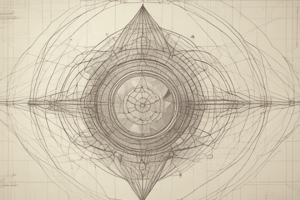Podcast
Questions and Answers
What is the formula for the surface area of a cone?
What is the formula for the surface area of a cone?
- πr² + πrl (correct)
- πr(l + r)
- 2πr² + 2πrh
- 4πr²
What is the relationship between the volume of a cone and a cylinder with the same base radius and height?
What is the relationship between the volume of a cone and a cylinder with the same base radius and height?
- The volume of the cone is twice that of the cylinder.
- The volume of the cone is one-fourth that of the cylinder.
- The volume of the cone is one-third that of the cylinder. (correct)
- The volume of the cone is the same as the cylinder.
What is the formula for the volume of a sphere?
What is the formula for the volume of a sphere?
- 2/3πr³
- (1/3)πr²h
- 4/3πr²
- 4/3πr³ (correct)
Which expression correctly represents the total surface area of a cone?
Which expression correctly represents the total surface area of a cone?
What is the surface area formula for a sphere with radius 'r'?
What is the surface area formula for a sphere with radius 'r'?
Flashcards
Cone Surface Area
Cone Surface Area
The area of the base plus the lateral surface of a cone.
Sphere Surface Area
Sphere Surface Area
The total outer area of a sphere, using its radius 'r'.
Cone Volume Formula
Cone Volume Formula
Volume of a cone = (1/3) * π * r² * h
Sphere Volume Formula
Sphere Volume Formula
Signup and view all the flashcards
Cone Base Area
Cone Base Area
Signup and view all the flashcards
Study Notes
Cone
- Surface Area: The surface area of a cone comprises the area of the base and the lateral surface area.
- Base Area: A circle with radius 'r'. Area = πr²
- Lateral Surface Area: Calculated using the slant height 'l' and the radius 'r'. Area = πrl
- Total Surface Area: The sum of the base area and lateral surface area. Total Surface Area = πr² + πrl
- Formula: SA = πr(l+r)
Sphere
- Surface Area: The entire exterior area of a sphere.
- Formula: The surface area of a sphere with radius 'r' is given by 4πr².
- Calculation: SA = 4πr²
Cone – Volume
- Volume: The amount of space enclosed within a cone.
- Formula: The volume of a cone with radius 'r' and height 'h' is given by (1/3)πr²h.
- Relationship to Cylinder: A cone's volume is one-third the volume of a cylinder with the same base radius and height.
- Calculation: V = (1/3)πr²h
Sphere – Volume
- Volume: The amount of space enclosed within a sphere.
- Formula: The volume of a sphere with radius 'r' is given by (4/3)πr³.
Studying That Suits You
Use AI to generate personalized quizzes and flashcards to suit your learning preferences.
Description
This quiz covers the formulas for calculating the surface area and volume of cones and spheres. It focuses on the relationships between the dimensions and the derived formulas necessary for solving related problems. Test your knowledge of geometry and solid figures with this quiz!




